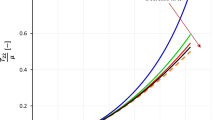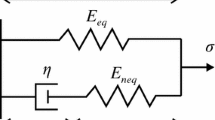Abstract
The modelling of off-axis simple tension experiments on transversely isotropic nonlinearly elastic materials is considered. A testing protocol is proposed where normal force is applied to one edge of a rectangular specimen with the opposite edge allowed to move laterally but constrained so that no vertical displacement is allowed. Numerical simulations suggest that this deformation is likely to remain substantially homogeneous throughout the specimen for moderate deformations. It is therefore further proposed that such tests can be modelled adequately as a homogenous deformation consisting of a triaxial stretch accompanied by a simple shear. Thus the proposed test should be a viable alternative to the standard biaxial tests currently used as material characterisation tests for transversely isotropic materials in general and, in particular, for soft, biological tissue. A consequence of the analysis is a kinematical universal relation for off-axis testing that results when the strain-energy function is assumed to be a function of only one isotropic and one anisotropic invariant, as is typically the case. The universal relation provides a simple test of this assumption, which is usually made for mathematical convenience. Numerical simulations also suggest that this universal relation is unlikely to agree with experimental data and therefore that at least three invariants are necessary to fully capture the mechanical response of transversely isotropic materials.







Similar content being viewed by others
References
Rivlin RS (1997). In: Barenblatt GI, Joseph DD (eds) Collected papers of R.S. Rivlin, vol 1. Springer, New York
Spencer AJM (1972) Deformations of fibre-reinforced materials. Oxford University Press, Oxford
Pagano NJ, Halpin JC (1968) Influence of end constraint in the testing of anisotropic bodies. J Compos Mater 2:18–31
Marín JC, Cañas J, París F, Morton J (2002) Determination of G\(_{12}\) by means of the off-axis tension test. Part I: review of gripping systems and correction factors. Compos A 33:87–100
Xiao Y, Kawai M, Hatta H (2010) An integrated method for off-axis tension and compression testing of unidirectional composites. J Compos Mater 45:657–669
Moon H, Truesdell C (1974) Interpretation of adscititious inequalities through the effects pure shear stress produces upon an isotropic elastic solid. Arch Ration Mech Anal 55:1–17
Rajagopal KR, Wineman AS (1987) New universal relations for nonlinear isotropic elastic materials. J Elast 17:75–83
Mihai LA, Goriely A (2012) Positive or negative Poynting effect? The role of adscititious inequalities in hyperelastic materials. Proc R Soc A (to appear)
Destrade M, Murphy JG, Saccomandi G (2012) Simple shear is not so simple. Int J Nonlinear Mech 47:210–214
Rivlin RS (1948) Large elastic deformations of isotropic materials. IV. Further developments of the general theory. Philos Trans R Soc Lond A 241:379–397
Gent AN, Suh JB, Kelly SG III (2007) Mechanics of rubber shear springs. Int J Nonlinear Mech 42:241–249
Horgan CO, Murphy JG (2010) Simple shearing of incompressible and slightly compressible isotropic nonlinearly elastic materials. J Elast 98:205–221
Humphrey JD, Yin FCP (1987) A new constitutive formulation for characterizing the mechanical behavior of soft tissues. Biophys J 52:563–570
Humphrey JD, Strumpf RK, Yin FCP (1990) Determination of a constitutive relation for passive myocardium: I. New Funct Form J Biomech Eng 112:333–339
Horgan CO, Murphy JG (2012) On the modeling of extension-torsion experimental data for transversely isotropic biological soft tissues. J Elast 108:179–191
Wenk JF, Ratcliffe MB, Guccione JM (2012) Finite element modeling of mitral leaflet tissue using a layered shell approximation. Med Biol Eng Comput 50:1071–1079
Ning X, Zhu Q, Lanir Y, Margulies SS (2006) A transversely isotropic viscoelastic constitutive equation for brainstem undergoing finite deformation. J Biomech Eng 128:925–933
Destrade M, Gilchrist MD, Prikazchikov DA, Saccomandi G (2008) Surface instability of sheared soft tissues. J Biomech Eng 130:0610071–0610076
Holzapfel GA, Gasser TC, Ogden RW (2000) A new constitutive framework for arterial wall mechanics and a comparative study of material models. J Elast 61:1–48
Holzapfel GA, Ogden RW, Gasser TC (2006) Hyperelastic modelling of arterial layers with distributed collagen fibre orientations. J R Soc Interface 3:15–35
Ogden RW (2003) Nonlinear elasticity, anisotropy, material stability and residual stresses in soft tissue. In: Biomechanics of soft tissue in cardiovascular systems, CISM courses and lectures series no. 441. Springer, Wien, pp 65–108
Holzapfel GA, Ogden RW (2009) On planar biaxial tests for anisotropic nonlinearly elastic solids. A continuum mechanical framework. Math Mech Solids 14:474–489
Ogden RW, Saccomandi G, Sgura I (2004) Fitting hyperelastic models to experimental data. Comput Mech 34:484–502
Nì Annaidh A, Bruyère K, Destrade M, Gilchrist MD, Maurini C, Otténio M, Saccomandi G (2012) Automated estimation of collagen fibre dispersion in the dermis and its contribution to the anisotropic behaviour of skin. Ann Biomed Eng 40:1666–1678
Moulton MJ, Creswell LL, Actis RL, Myers KW, Vannier MW, Szabo BA, Pasque MK (1995) An inverse approach to determining myocardial material properties. J Biomech 28:935–948
Yeoh OH, Fleming PD (1997) A new attempt to reconcile the statistical and phenomenological theories of rubber elasticity. J Polym Sci B 35:1919–1931
Yamamoto E, Hayashi K, Yamamoto N (1999) Mechanical properties of collagen fascicles from the rabbit patellar tendon. J Biomech Eng 121:124–131
Van Kerckhoven R, Kalkman EAJ, Saxena PR, Schoemaker RG (2000) Altered cardiac collagen and associated changes in diastolic function of infarcted rat hearts. Cardiovasc Res 46:316–323
Guo D-L, Chen B-S, Liou N-S (2007) Investigating full-field deformation of planar soft tissue under simple-shear tests. J Biomech 40:1165–1170
Atkin RJ, Fox N (1980) An introduction to the theory of elasticity. Longman, London
Dokos S, Smaill BH, Young AA, LeGrice IJ (2002) Shear properties of passive ventricular myocardium. Am J Physiol Heart Circ Physiol 283:H2650–H2659
Horgan CO, Murphy JG (2011) Simple shearing of soft biological tissues. Proc R Soc A 467:760–777
Author information
Authors and Affiliations
Corresponding author
Appendix
Appendix
1.1 Numerical results
The following procedure was adopted to calculate the kinematical quantities \(\lambda _{1},\lambda _{2},\kappa \) from the numerical results. The \(x_{1}\) coordinates of the mid-points of the inclined faces were isolated from the rest of the output data at specified values of the prescribed axial stretch; call them \(x_{1}^{l},x_{1}^{r}\), using an obvious notation. Referring to Fig. 3, let the origin coincide the bottom left corner of the undeformed block. Since the dimensions of the block were chosen to be \(20\,\times \, 20\, \times \, 2\,\text{ mm }\), it follows from (9) that
Since \(\lambda _{2}\) is controlled, \(\kappa , \lambda _{1}\) are therefore obtained from
These calculated quantities to four decimal places are tabulated in Table 1.
1.2 Comparative plots
Numerical results for a fibre angle of \(45\,^{\circ }\) were presented in the main body of the paper. The simulations for this natural choice of fibre angle are supplemented below for an angle close to the horizontal and another close to the vertical. For the material parameters used here, it is clear from Figs. 8 and 9 that shear is negligible for a \(20\,^{\circ }\) angle and much more pronounced for \(80\,^{\circ }\). A comparison of these graphics with Fig. 3 shows that the amount of shear for \(45\,^{\circ }\) is between these two limiting cases.
Rights and permissions
About this article
Cite this article
Destrade, M., Donald, B.M., Murphy, J.G. et al. At least three invariants are necessary to model the mechanical response of incompressible, transversely isotropic materials. Comput Mech 52, 959–969 (2013). https://doi.org/10.1007/s00466-013-0857-4
Received:
Accepted:
Published:
Issue Date:
DOI: https://doi.org/10.1007/s00466-013-0857-4






